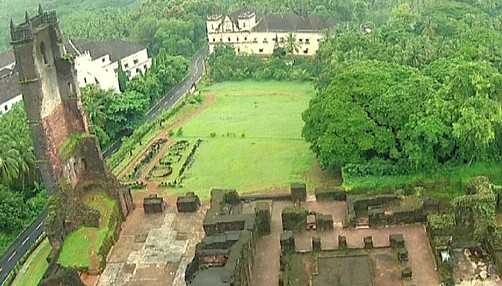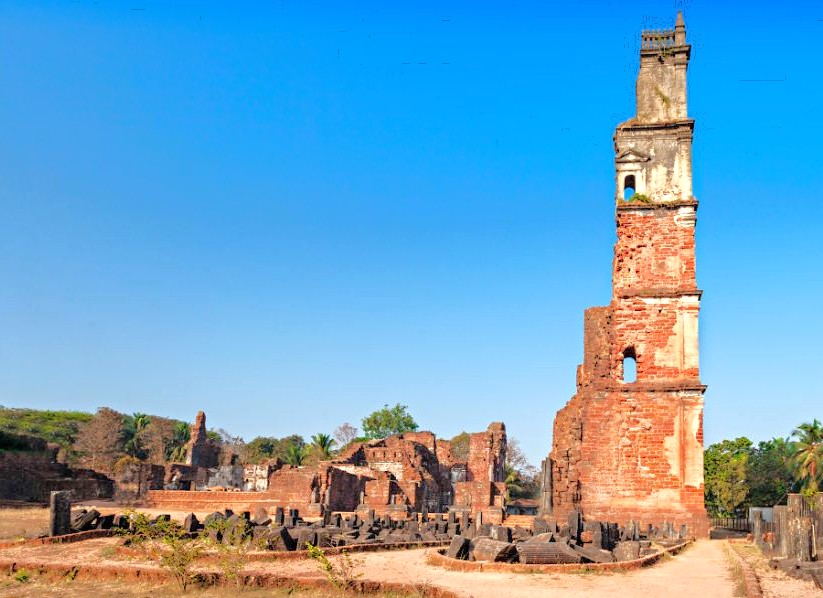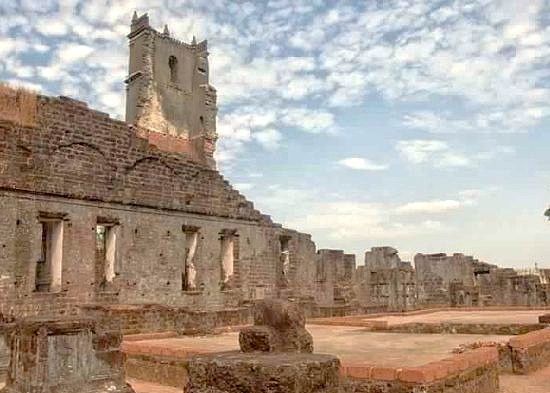Echoes of Ancient Lands
Church of Saint Augustine Old Goa
Mother Masala Tours
The Tower That Stands: A Testament to Resilience
Church of Saint Augustine Old Goa. Standing on Monte Santo in Old Goa as symbols of historical grandeur. Augustinian friars established this complex between 1597 and 1602 when Old Goa served as the center of Portuguese India. The original structure included four impressive towers that helped sailors navigate through the Mandovi River. The church was dedicated to Nossa Senhora da Graça and ranked among the largest religious buildings of its era. Portuguese authorities ordered religious orders to leave in the early 19th century, which led to the church's abandonment. The roof collapsed in 1842, followed by further deterioration. Today, only one tower remains at 46 meters tall. The ruins gained Unesco World Heritage status in 1986, preserving this significant piece of colonial history.

Church of Saint Augustine Old Goa: Sacred Spaces
Originally, the Church, Tower and convent were connected to monastic life and served as religious hubs of immense influence. The complex had eight side chapels, four main altars, and a massive convent attached to the church. Fragments of the gilded altars and intricate wooden sculptures still survive today. Carvings of biblical figures and depictions of saints adorned the walls, bringing the stories of faith to life for all those who entered the church. The interior boasted high vaulted ceilings with light filtering through its arches, creating a peaceful yet awe-inspiring atmosphere. The vast convent spaces adjoining the church were home to the Augustinian friars who dedicated their lives to prayer, teaching, and missionary activity.
Ancient Mosaics: Impeccable Craftsmanship

The artistry of the Church is revealed through the surviving details scattered across the ruins. The grand altar, crafted with gold leaf and adorned with intricate carvings, was a masterpiece of its time. The façade, built with red laterite stone typical of Goan construction, was adorned with carvings of angels, floral designs, and religious motifs. The four bell towers, including the one that still stands today, were built with great precision and craftsmanship. Incredibly, the artisans incorporated elements of Goan, Portuguese, and Renaissance styles to create a unique visual language.
The Pulse of the Local Community
Church of Saint Augustine Old Goa. The people of Old Goa share a deep connection to the tower, preserving it as a cherished piece of their heritage. For generations, this structure has been a source of inspiration, not only for its spiritual past but for the cultural and architectural legacy it represents. The local community radiates a sense of warmth, fostering an atmosphere of respect and reflection for everyone who visits the ruins.
Capturing the Magic: A Photographic Haven

The solitary tower at Saint Augustine rises above the surrounding ruins with moss-covered stones creating texture in photographs. Morning light casts long shadows across the historic site while sunset gives the stones a golden glow against blue skies. The tower stands approximately 46 meters tall with multiple levels that provide different perspectives for camera angles. Photographers often capture the contrast between ancient stonework and the green vegetation growing throughout the area.
Festivals of Devotion: Honouring the Sacred and the Divine
The Church has long been entwined with Goa’s devotion to saints and heavenly celebrations. Although the church no longer hosts services, events such as the Feast of Saint Francis Xavier draw thousands to Old Goa every December. During this time, the ruins around the church are filled with music, prayer, and a sense of reverence for the divine. The feast, marked by processions and traditional Konkani hymns, further binds the spiritual history of sites like Saint Augustine to Goa’s modern life. These gatherings celebrate not only religious devotion but the enduring hope of preserving faith-guided traditions.
The Connection with the Gods

The Augustine Church once contained various religious figures and symbols that represented important Catholic traditions. The structure housed images of numerous saints alongside Nossa Senhora da Graça who held special significance in this location. These religious icons were created by skilled artisans who combined European artistic techniques with some local influences. The remaining tower allows people to imagine where these sacred objects once stood within the larger complex. Several stone carvings that survived show how these religious figures connected to everyday life in colonial Goa.
Ancient Technologies: Sound, Sacred Geometry & Astrological Influences
Church of Saint Augustine Old Goa. The builders of the Church and Tower, employed advanced techniques for its time, incorporating sound and space in ways that elevated the religious experience. The massive naves allowed the resonance of hymns to echo across the church’s large interiors, creating a meditative impact for those who attended services. The tower’s careful layout ensured architectural stability, with proportions following principles of European Renaissance geometry. The materials - red laterite stone and burnt brick - were chosen for resilience against the elements.
Resilience and Renewal: Overcoming Adversity’s Challenges

The collapse of Church symbolizes both the passage of time and the forces of adversity it faced over decades. In 1835, under the rule of Portuguese colonial authorities, the eviction of Augustinian orders marked the first blow to the complex’s survival. Abandoned and left unattended, it gradually fell to ruin. By 1931, years of neglect had caused catastrophic damage to its arches and ceilings. The site remains one of Goa’s most treasured cultural symbols. Conservation efforts led by the Archaeological Survey of India, along with Unesco's recognition, have ensured that this landmark remains a vital part of global history.
Urban Legends: Strange Sightings, Myths, and Mysteries
Church of Saint Augustine Old Goa. Legends about the ruins have persisted for years. One popular story involves mysterious sounds at midnight that some associate with ghostly monks from centuries past. Another enduring myth tells of gold or relics buried beneath the church floor, though no evidence of treasure has ever been found. These stories add a sense of mystery and intrigue to this already atmospheric landmark.
Serendipitous Meetings: Beyond the Main Path

The Augustine Church in Old Goa once contained various religious figures and symbols that represented important Catholic traditions. The structure housed images of numerous saints alongside Nossa Senhora da Graça who held special significance in this location. These religious icons were created by skilled artisans who combined European artistic techniques with some local influences. The remaining tower allows people to imagine where these sacred objects once stood within the larger complex. Religious ceremonies involved these figures through elaborate processions and daily prayer routines practiced by monks who lived there.
India, Beyond Ordinary Moments Is An Understatement
Join us, see the impressive historical landmark with walls that have witnessed centuries of change. These ruins contain architectural details that show the building techniques from colonial periods of Portuguese influence in India. Walking through the remaining sections gives people an idea of how massive this structure once appeared on the landscape. The main tower rises dramatically above the surrounding vegetation and creates interesting shadows throughout the day. These stone pathways connect different areas where religious ceremonies once took place according to historical records. The space transforms throughout the day as sunlight moves across the weathered stones and creates different visual effects. Many consider this location an essential stop when exploring the Unesco heritage sites around Old Goa.
Symphony of Generosity: Offerings from Wanderers to Residents

The Saint Augustine ruins create opportunities for meaningful exchanges between tourists and local businesses. Visitors purchase handcrafted souvenirs from nearby shops while learning about traditional Goan crafts directly from artisans. Small restaurants serve authentic regional dishes, introducing travelers to local flavors and cooking techniques. Shop owners share stories about the area while tourists bring economic support to family-owned establishments. These daily interactions create lasting connections between cultures.